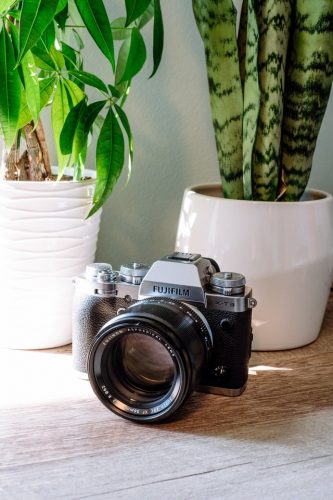Over the years, Fujifilm has started surpassing some of its direct competitors. The new X-T4 follows the same path. It fixes some of the last things that needed to be addressed like the IBIS, battery, and further improves the performance. Fujifilm has done a utility update on the new Fujifilm X-T4, pretty much giving the photography community everything they’ve asked for. They’ve also given vloggers everything they could want as well. The improvements made to the Fuji X-T4 make this new model one of the most exciting and complete APS-C cameras you can find today. It’s not meant to replace the X-T3 that still remains on the market. So let’s compare the X-T3 and X-T4 to find the key differences between the two cameras.
Five Axis Image Stabilization
This is the biggest upgrade to the Fuji X-T4. Up until now, Fujifilm had produced only one camera with in-body stabilization, the X-H1. The Fuji X-T4 from Buydig.com incorporates a smaller and lighter unit. Instead of springs, the new mechanism works with magnetic force and has an improved structure to absorb shock. The new gyro sensor improves the detection accuracy by 8 times in comparison to the X-H1. The internal image stabilization works for video too and you can add software stabilization, called DIS (Digital Image Stabilization). The field of view is cropped 1.1x, but the degree of stabilization is improved. There’s also a new IS Boost mode that’s designed to stabilize the image for fixed shots when you’re not using a tripod. The Fuji X-T3 doesn’t have any sort of stabilization.
Larger Battery
The new battery introduced with the X-T4 has a higher amperage of 2350mAh, which is almost double the capacity of the previous one. The X-T3 can take around 390 shots with a fully charged battery, whereas the X-T4 can manage around 500 shots. In addition to the Normal and Boost modes, Fuji has added a new Economy mode that can save even more power.

LCD Monitor
The X-T3 from Buydig.com has an unusual 3-way tilting mechanism. In addition to tilting up and down, it can be oriented by about 70 degrees when working in vertical orientation. The rear monitor on the X-T4 has a multi-angle mechanism, and gives you more possibilities including a 180-degree rotation on the side. The LCD on the Fuji X-T4 also has more resolution. Both screens are touch sensitive and allow you to perform different operations such as taking a shot, moving the focus point, selecting specific settings and so on.
Shutter Unit and Continuous Shooting
The Fuji X-T4 features a new shutter mechanism that is rated at 300,000 actuations and has a quieter sound. The X-T4 shutter has a new design that allows it to be faster, reaching a maximum speed of 15fps in continuous mode. With the mechanical shutter, the Fuji X-T3 can go as fast as 11fps. If you want a live view, you need to decrease the speed to 5fps, whereas the Fuji X-T4 can do this at 8fps. If you need faster burst speeds, both cameras can go up to 20fps with the electronic shutter, or 30fps with the electronic shutter and crop mode.
Autofocus Software
The X-T4 has a new algorithm where in addition to distance, color and shape data are also analyzed to improve accuracy. Tracking has been improved and is 2 x’s more accurate in comparison to the X-T3. Low light sensitivity is -6Ev versus -3Ev on the X-T3. The speed has increased for a locking speed of 0.02s. Face and Eye detection have the same tweaks given to the X-T3 via firmware. The technology inside the cameras is the same. They both have a hybrid system with contrast and phase detection points. This means that the X-T3 could receive some of the new software improvements via firmware later on.
Image Quality Settings
The Fuji X-T4 introduces a new film simulation mode called Eterna Bleach Bypass, which emulates a traditional processing method for silver halide film. It’s low in saturation but high in contrast. There’s also the Classic Neg profile and the Color Chrome Effect Blue mode. The X-T3 has the normal Chrome Effect. Other tweaks have been added for other settings. For example, highlights and shadows can be controlled in ½ steps instead of 1, and White Balance has a new White Priority and Ambience priority depending on the type of artificial light you’re working with. Finally, a Compressed option has been added to the RAW settings in addition to uncompressed and lossless compressed found on the X-T3. With the built-in RAW Converter, you can export 8-bit and 16-bit TIFF files as well as JPGs.

Video Recording
Both cameras can record 4K up to 60p and 200Mbps, or 4K up to 30p and 400Mbps. What’s new on the Fuji X-T4 is the maximum frame rate in Full HD, which goes up to 240fps. The Fuji X-T3 can do a maximum of 120fps. Other improvements on the Fuji X-T4 include the possibility to record video on both cards at the same time, and the F-Log View Assist which allows you to display normal contrast and colors when recording with Log.
Menu
The most important change is that now, stills and video have a separate menu depending on the position of the switch on the X-T4. There’s also a “Movie optimized control” option that allows you to adjust the exposure with the command dial or the touch screen. The X-T3 has a similar setting called Movie Silent Control that allows you to control all the settings via the touch screen.
Fujifilm did a couple of cool things with the new X-T4 like improving the shutter, making it near-silent, and they’re using a magnetic style IBIS system. The X-T4 will be the last camera you need for a long time.


Leave a Reply